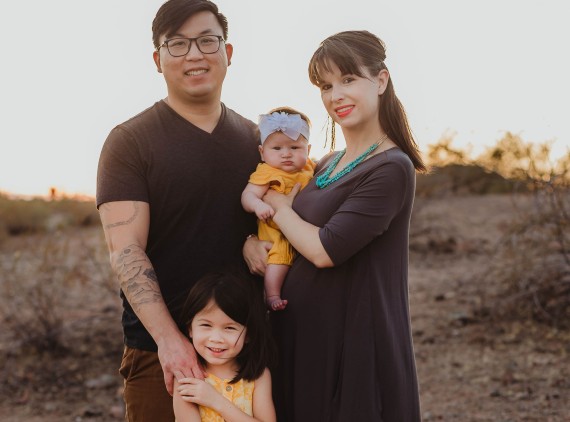Now an energetic and happy toddler, Gwen was born with multiple heart malformations and other congenital defects. But she has not let it slow her down. Instead, Gwen is making her own way - defying expectations and teaching her family to live in the moment. Watch the video to see how Gwen is doing today.
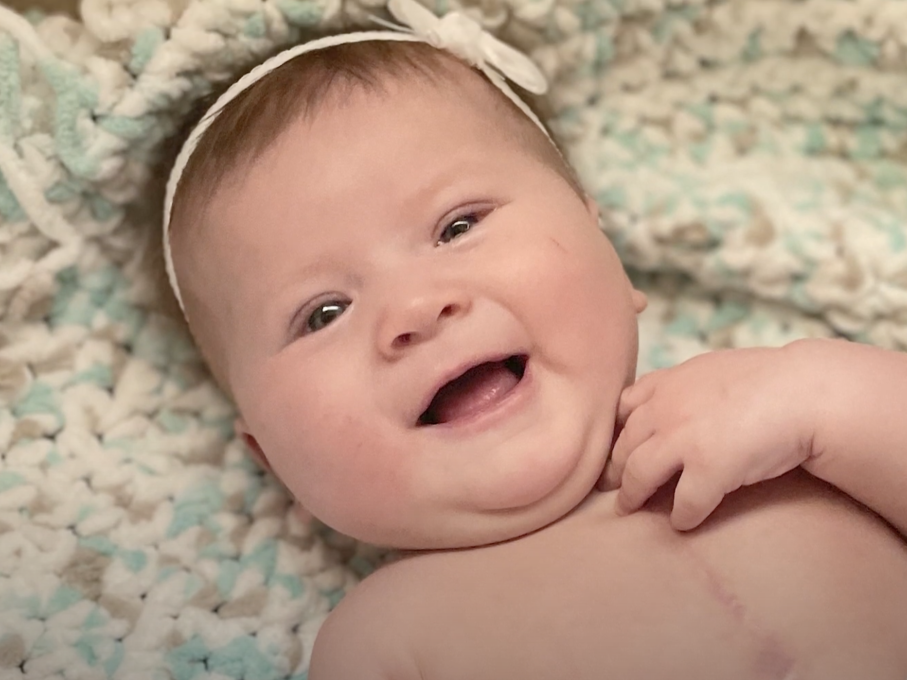
“We very much were a family that planned our lives to a ‘T,’” said Gwen’s mother, Amanda. “But Gwen’s a cardio kid, and that’s forced us to stop all of the over-planning and live in the moment. Even though she’s doing great today, we have no idea what tomorrow may be like. So we are grateful for every moment that we’re able to enjoy as a family.”
The Theoretical Gets Real for Scientist Mom

A molecular biologist and bioethicist with a background in neuroscience and genetics, Amanda had spent time volunteering in a center that diagnoses children with rare genetic conditions. Additionally, much of her own research has focused on the ethics of prenatal genetic testing. So even before she became pregnant with Gwen, Amanda was familiar with problems that could arise for a developing fetus.
When Amanda went to her OB/GYN for the routine 19-week ultrasound in late 2020, the only surprise she expected was finding out the gender of her second child. But her heart sank when the ultrasound technician went to get the doctor. Even more difficult, Amanda was alone: COVID-19 protocol prevented her husband, Jon, from accompanying her to the appointment.
“I knew that ultrasound technicians doing routine prenatal scans don’t usually get the doctor unless there’s bad news,” Amanda shared.
Detecting problems with the baby’s heart, stomach and liver, Amanda’s OB/GYN sent her immediately to a high-risk pregnancy specialist, who suspected heterotaxy, a rare birth defect that involves the heart and other organs in the chest and abdominal areas – many of which are mislocated. From there, she was sent to see the fetal cardiology specialists at Phoenix Children’s.
MRI Finds Multiple Organs Mislocated
At Phoenix Children’s, Amanda underwent additional imaging tests, including a fetal magnetic resonance imaging (MRI) scan and an echocardiogram for a closer evaluation of the heart and other organs. Pediatric cardiologist Christopher L. Lindblade, MD, confirmed heterotaxy with mesocardia, a condition in which the heart is in an abnormal location. Other organs, including Gwen’s stomach and liver, were mislocated. The baby also had two left lungs and multiple spleens.
Gwen was diagnosed with multiple heart defects involving the heart valves and blood flow between the heart and lungs, including an unbalanced atrioventricular canal (allowing blood to move freely throughout the four heart chambers) and pulmonary atresia (where the pulmonary artery doesn’t form). She also had only one ventricle doing all of the pumping. That meant that while her heart could receive blood from the lungs, it wouldn’t be able to pump oxygenated blood back to the lungs and throughout the body.
“We knew at that point, at 21 weeks gestation, that the baby would need multiple cardiac surgeries, and possibly other interventions, once she was born,” said Dr. Lindblade, who also is medical director of the Fetal Cardiology Program. “We monitored the baby’s progress throughout the rest of Amanda’s pregnancy, and we connected the family to services they would need before and after birth. We wanted to be able to pass the baton to the next group of providers.”
Preparing for a Bumpy Start
Even under the best circumstances, preparing for a baby’s arrival is overwhelming. But planning for a child with life-threatening heart abnormalities and other conditions is fraught with anxiety, stress and a host of other complicated emotions. Dr. Lindblade connected Amanda and Jon with other services at Phoenix Children’s to help them prepare for the long road ahead, including fetal heart surgery, maternal mental health, genetics and palliative care.
Amanda and Jon quickly became involved with mental health services at Phoenix Children’s. Doing so allowed them to talk through the changes they could expect once Gwen was born, strengthening their relationship to prepare for the challenges ahead.
“We suddenly were confronted with a situation we never had to deal with because our health has been good – we were not a medicalized family,” Amanda said. “I’ve seen these situations from the outside when working with families with rare disease, but I’d never actually had to engage with them. So, we got mental health support for what was about to come, which was the hardest thing we’ve ever gone through.”
Child Life Prepares Big Sister
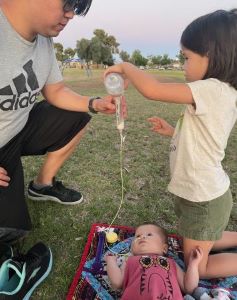
The family also connected with Child Life specialists at Phoenix Children’s to help their older daughter, Addie, then 5, prepare for her baby sister’s birth. The baby’s health problems, combined with the COVID-19 pandemic, meant that Addie would not be able to visit the baby at first. She also would be separated from her parents for an extended period after the baby’s birth. Plus, once Gwen was able to come home, she would be attached to special equipment and need special care beyond the usual needs of newborns.
The Child Life team did several things to help prepare Addie. They gave her special coupons to use when she needed a phone call with her mom or dad or a face-to-face visit through a window at the hospital. They gave the family books with tips for staying connected and dealing with the heavy emotions involved in these situations. Additionally, they gave Addie a bear wearing the same kind of equipment Gwen would be using.
“As the weeks went on after Gwen arrived, we were able to deploy the different strategies as Addie struggled through this,” Amanda said. “She’s been an amazing big sister. She's grown so much since Gwen’s birth.”
Palliative Care Support
The family also wanted to advocate for Gwen’s quality of life, so they became involved with palliative care during the pregnancy. After Gwen was born, the palliative care team helped the family advocate for things such as weaning the baby off certain medications more slowly to give her body time to adjust. They also advocated for Amanda and Jon to be able to hold Gwen early on, even though she was on a ventilator.
“In pediatric palliative care, our role is to provide an extra layer of support to kids and families when there is medical complexity,” said Billie A. Winegard, MD. “In these situations, often parents are asked to make hard decisions about conditions that are potentially life limiting. Obviously, this isn’t what families hope for, and it’s a very stressful time for them. So, in palliative care, we want to support them as well as we can. We take a step back and provide more holistic care beyond the medical concerns.”
Comprehensive Care After Birth
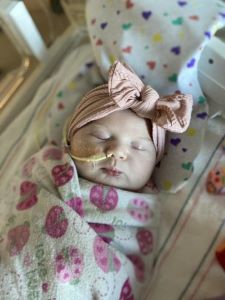
Within hours of her birth in January 2021, Gwen was taken to Phoenix Children’s and admitted to the Cardiovascular Intensive Care Unit (CVICU). Staffed by a team of pediatric cardiac critical care physicians with specialized training and congenital heart disease expertise, the CVICU is dedicated to the clinical care of critically ill children like Gwen who have cardiac conditions and are waiting to undergo procedures such as heart surgery or cardiac catheterization.
Gwen had her first open heart surgery at 10 days old. Doctors inserted an artificial ductus arteriosus (blood vessel that connects major arteries) to allow blood to move into the lungs and then be pushed back into the body with oxygen.
The period between a first and second heart surgery is called the “interstage.” During this time, the risk of complications is higher. Gwen was moved into Phoenix Children’s interstage monitoring program, Cardiac High Acuity Monitoring Program for Infants and Newborns (CHAMPION). The program is designed to improve the outcomes for children like Gwen who are born with a single ventricle.
Gwen had her second open heart surgery at five months. At some point, Amanda said, Gwen likely will need a heart transplant. But she’s hopeful that it won’t be necessary until Gwen is a young adult, or perhaps even older.
After birth, the genetics team at Phoenix Children’s diagnosed Gwen with primary ciliary dyskinesia (PCD). A rare genetic disorder caused by defects in the tiny hair-like structures that protect various parts of the body, including the respiratory passages, PCD puts her at a higher risk for infections.
A Ball of Energy
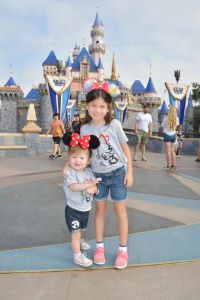
Now, at 19 months old, Gwen is meeting her developmental milestones and defying expectations. For example, Gwen’s medical team expected her to be on a feeding tube until she was a year old. But she was able to go off it at seven months. She is walking, talking and playing just like any other toddler her age.
"Gwen is a little ball of energy,” Amanda said. “She’s been a little fighter since the beginning. Mentally, we were prepared for the worst-case scenario, but she’s done everything the doctors said she would not be able to do. She proved that she by no means was a normal kid in the cardio world, and she’s doing amazingly well. We are so grateful for the care she has received at Phoenix Children’s.”

